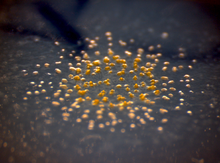- Myxococcus xanthus
-
Myxococcus xanthus 
Scientific classification Kingdom: Bacteria Phylum: Proteobacteria Class: Delta Proteobacteria Order: Myxococcales Family: Myxoccaceae Genus: Myxococcus Species: M. xanthus Binomial name Myxococcus xanthus
Beebe 1941Myxococcus xanthus colonies exist as a self-organized, predatory, saprotrophic, single-species biofilm called a swarm. Myxococcus xanthus, which can be found almost ubiquitously in soil, are thin rod shaped, gram-negative cells that exhibit self-organizing behavior as a response to environmental cues. The swarm, which has been compared to a "wolf-pack," modifies its environment through stigmergy. This behavior facilitates predatory feeding, as the concentration of extracellular digestive enzymes secreted by the bacteria increases. M. xanthus is a model organism for studying development, the behavior in which starving bacteria self-organize to form fruiting bodies: dome shaped structures of approximately 100,000 cells. These swarms differentiate into metabolically quiescent and environmentally resistant myxospores over the course of several days. During this process of self-organizing, dense ridges of cells move in traveling waves (ripples) that grow and shrink over several hours.
A swarm of M. xanthus is a distributed system: a population of millions of identical entities that communicate among themselves in a non-centralized fashion, thus behaving as a single entity. The cells within the swarm form a collective, exhibiting coordinated movement through a series of signals to create dynamic patterns in response to environmental cues. One of these behaviors, development (mentioned above), is controlled through a cascade, or series, of transcriptional regulators (TR) that control downstream gene expression. It has been proposed that all emergent, or self-organizing, behavior in M. xanthus is under this type of control.
Contents
Genomics
The complexity of the M. xanthus life cycle is reflected in its 9.14 Megabase genome, the largest prokaryotic genome sequenced until the sequencing of Sorangium cellulosum (12.3 Mb). The M. xanthus genome was sequenced[1] by Monsanto Company and The Institute for Genomic Research (TIGR) and is currently available in GenBank.
Medical relevance
Beyond its use as a model for self-organization, M. xanthus also produces hundreds of potentially valuable secondary metabolites. During predation, M. xanthus releases over 300 secondary metabolites, many of which are used to lyse the cells of soil microbes on which it feeds. Many of these secondary metabolites are known to have medicinal properties. For example, M. xanthus produces myxalamid, an antibiotic that targets yeasts, molds, and enterobacteria. M. xanthus is also one of the most genetically tractable myxobacteria, and there is a considerable body of ongoing research aimed at genetically modifying M. xanthus to overproduce these compounds in a controlled environment, such as a fermentor. Current work includes the heterologous production of Epothilone B, a polyketide capable of targeting breast cancer cells that is superior to the anti-tumor drug Taxol. Finally, M. xanthus offers potential utility in the agricultural arena. Published data indicate that M. xanthus may act as a bacterial biological control agent to inhibit pathogenic fungi in plants.
Motility
M. xanthus cells exhibit a type of surface-mediated motility known as twitching motility. Twitching is mediated by a Type IV pilus that extrudes through the pole of the cell. The pilus is extended by the addition of pilin monomers at the base of the pilus. The tip of the pilus binding to a substrate in the biofilm sends a signal for the pilus to retract by the removal of pilin subunits. The shortening of the pilus leads to the cell being dragged along the surface towards the tip of the pilus. The mechanism of the Type IV pilus has been likened to a grappling hook. The pilus apparatus is only constructed at one pole at a given time, but the location is dynamic and dependent upon chemotactic signals.
In addition to Type IV pilus mediated group motility, M. xanthus cells also move individually using gliding motility on solid surfaces. Cells move in one direction along their long axis, then pause and continue movement in the opposite direction. The molecular mechanisms driving gliding motility are currently unknown.
See also
- Pxr sRNA
References
- ^ B. S. Goldman, W. C. Nierman, D. Kaiser, S. C. Slater, A. S. Durkin, J. A. Eisen, C. M. Ronning, W. B. Barbazuk, M. Blanchard, C. Field, C. Halling, G. Hinkle, O. Iartchuk, H. S. Kim, C. Mackenzie, R. Madupu, N. Miller, A. Shvartsbeyn, S. A. Sullivan, M. Vaudin, R. Wiegand, and H. B. Kaplan. Evolution of sensory complexity recorded in a myxobacterial genome. Proc. Natl. Acad. Sci. USA. 103(41):15200–15205.
External links
Categories:
Wikimedia Foundation. 2010.
